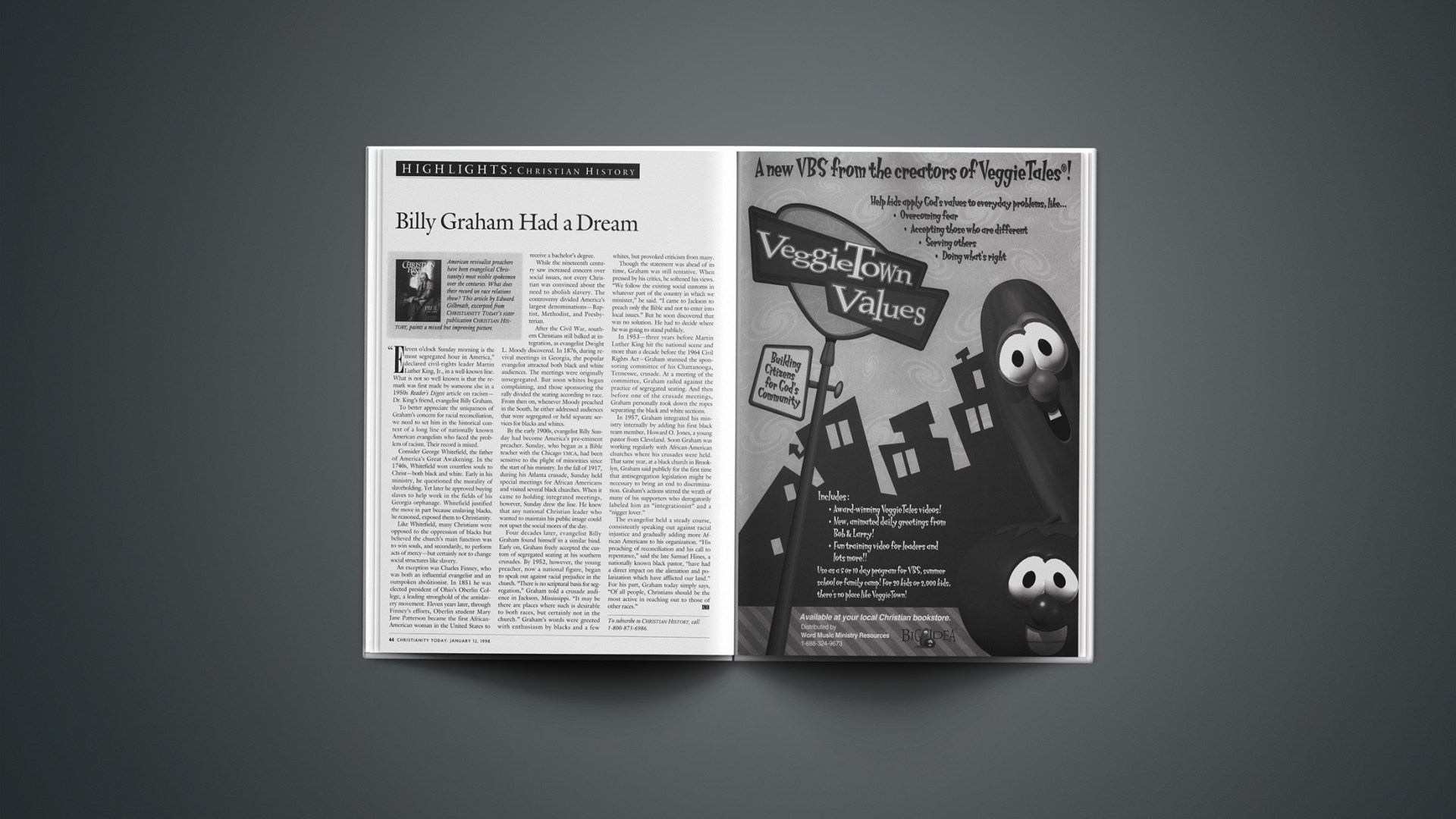American revivalist preachers have been evangelical Christianity's most visible spokesmen over the centuries. What does their record on race relations show? This article by Edward Gilbreath, excerpted from CHRISTIANITY TODAY's sister publication CHRISTIAN HISTORY, paints a mixed but improving picture.
Eleven o'clock Sunday morning is the most segregated hour in America," declared civil-rights leader Martin Luther King, Jr., in a well-known line. What is not so well known is that the statement was also made by someone else in a 1960 Reader's Digest article on racism—Dr. King's friend, evangelist Billy Graham.
To better appreciate the uniqueness of Graham's concern for racial reconciliation, we need to set him in the historical context of a long line of nationally known American evangelists who faced the problem of racism. Their record is mixed.
Consider George Whitefield, the father of America's Great Awakening. In the 1740s, Whitefield won countless souls to Christ—both black and white. Early in his ministry, he questioned the morality of slaveholding. Yet later he approved buying slaves to help work in the fields of his Georgia orphanage. Whitefield justified the move in part because enslaving blacks, he reasoned, exposed them to Christianity.
Like Whitefield, many Christians were opposed to the oppression of blacks but believed the church's main function was to win souls, and secondarily, to perform acts of mercy—but certainly not to change social structures like slavery.
An exception was Charles Finney, who was both an influential evangelist and an outspoken abolitionist. In 1851 he was elected president of Ohio's Oberlin College, a leading stronghold of the antislavery movement. Eleven years later, through Finney's efforts, Oberlin student Mary Jane Patterson became the first African-American woman in the United States to receive a bachelor's degree.
While the nineteenth century saw increased concern over social issues, not every Christian was convinced about the need to abolish slavery. The controversy divided America's largest denominations—Baptist, Methodist, and Presbyterian.
After the Civil War, southern Christians still balked at integration, as evangelist Dwight L. Moody discovered. In 1876, during revival meetings in Georgia, the popular evangelist attracted both black and white audiences. The meetings were originally unsegregated. But soon whites began complaining, and those sponsoring the rally divided the seating according to race. From then on, whenever Moody preached in the South, he either addressed audiences that were segregated or held separate services for blacks and whites.
By the early 1900s, evangelist Billy Sunday had become America's pre-eminent preacher. Sunday, who began as a Bible teacher with the Chicago YMCA, had been sensitive to the plight of minorities since the start of his ministry. In the fall of 1917, during his Atlanta crusade, Sunday held special meetings for African Americans and visited several black churches. When it came to holding integrated meetings, however, Sunday drew the line. He knew that any national Christian leader who wanted to maintain his public image could not upset the social mores of the day.
Four decades later, evangelist Billy Graham found himself in a similar bind. Early on, Graham freely accepted the custom of segregated seating at his southern crusades. By 1952, however, the young preacher, now a national figure, began to speak out against racial prejudice in the church. "There is no scriptural basis for segregation," Graham told a crusade audience in Jackson, Mississippi. "It may be there are places where such is desirable to both races, but certainly not in the church." Graham's words were greeted with enthusiasm by blacks and a few whites, but provoked criticism from many.
Though the statement was ahead of its time, Graham was still tentative. When pressed by his critics, he softened his views. "We follow the existing social customs in whatever part of the country in which we minister," he said. "I came to Jackson to preach only the Bible and not to enter into local issues." But he soon discovered that was no solution. He had to decide where he was going to stand publicly.
In 1953—three years before Martin Luther King hit the national scene and more than a decade before the 1964 Civil Rights Act—Graham stunned the sponsoring committee of his Chattanooga, Tennessee, crusade. At a meeting of the committee, Graham railed against the practice of segregated seating. And then before one of the crusade meetings, Graham personally took down the ropes separating the black and white sections.
In 1957, Graham integrated his ministry internally by adding his first black team member, Howard O. Jones, a young pastor from Cleveland. Soon Graham was working regularly with African-American churches where his crusades were held. That same year, at a black church in Brooklyn, Graham said publicly for the first time that antisegregation legislation might be necessary to bring an end to discrimination. Graham's actions stirred the wrath of many of his supporters who derogatorily labeled him an "integrationist" and a "nigger lover."
The evangelist held a steady course, consistently speaking out against racial injustice and gradually adding more African Americans to his organization. "His preaching of reconciliation and his call to repentance," said the late Samuel Hines, a nationally known black pastor, "have had a direct impact on the alienation and polarization which have afflicted our land." For his part, Graham today simply says, "Of all people, Christians should be the most active in reaching out to those of other races."
To subscribe to Christian History, call 1-800-873-6986.
Copyright © 1998 Christianity Today. Click for reprint information.










